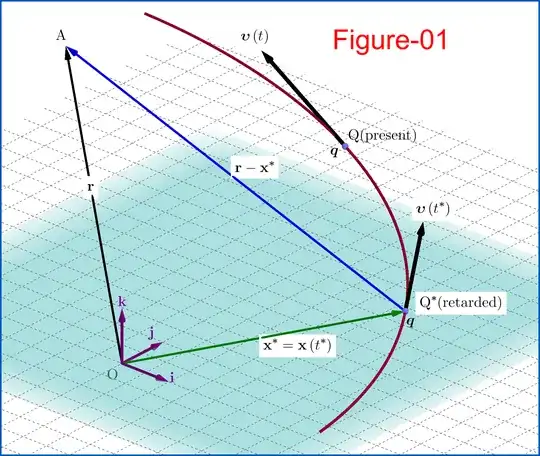EDIT: Added Clarification.
By various methods, it's possible to determine that in the formula for Electric potential for the position of a charge in uniform motion, $V=\frac{q}{4\pi\epsilon_0\kappa \cdot c(t-t_r)}$
Where $c(t-t_r)$ is the distance between field point and charge at the retarded time, and $\kappa=1-\frac{\vec{\beta}\cdot (\vec{x}-\vec{u}t_r)}{c(t-t_r)}$
$\vec{\beta}$ is velocity divided by c. The position of the charge at a given time $t$ is $\vec{u}t$
and the following equalities hold.
$$D=\sqrt{(x-ut)^2+(y^2+z^2)/\gamma^2}$$
where $\gamma=\frac{1}{\sqrt{1-\beta^2}}$ and $\beta=u/c$, where $v$ is the uniform velocity of the charge.
Also, $D=c(t-t_r)-\vec{\beta}\cdot(\vec{x}-\vec{u}t_r)=\kappa c(t-t_r).$
Now $D$ is not the distance between the field point $\vec{x}$ and the charge at retarded time $\vec{u}t_r$. Yet $V=\frac{q}{4\pi\epsilon_0D}$.
How is one to interpret $D$?
As a commenter suggested, it might be better to consider the change happening to the charge. Instead of $q$ we have $q_{eff}=q/\kappa$ and use the retarded time distance in the denominator $V=\frac{q_{eff}}{4\pi \epsilon_0\cdot c(t-t_r)}$.
Now the distance used makes sense, it's the distance to the charge between the field point and the charge location at the retarded time. But what is the physical meaning of this adjusted charge? While it makes the math work and allows for the use of a physically meaningful distance in the formula, it introduces additional questions. What is the physical meaning of adjusting the charge like this? A charge is a Lorentz invariant and $\kappa \neq \gamma$.
That the formula takes this form can be explained by the need to rescale the charge density and component of displacement in the direction of motion, but this fails to explain the new formula in terms of the retarded time.
